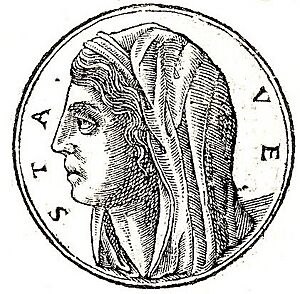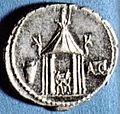Vesta (mythology) facts for kids
Vesta was a very important goddess in Roman mythology. She was known as the goddess of the hearth, which is like a fireplace, and also of the home and family. The Romans believed she protected everything that was most important for their daily lives and survival.
Vesta was special because she rarely appeared in drawings or statues. Instead, her presence was shown by a sacred fire that burned constantly in her temple. This fire was super important! Only her special priestesses, called the Vestal Virgins, were allowed inside her temple.
The Romans saw Vesta as an example of how they thought women should be: modest and not always sharing their opinions. She wasn't a main character in many myths, but her role was vital for Roman life.
The asteroid 4 Vesta is named after her.
Her Sacred Fire
Vesta's most important symbol was her sacred fire. This fire was kept burning all the time in her temple in Rome. It was believed that if the fire ever went out, it would bring bad luck to the entire Roman Empire. Keeping the fire lit was a huge responsibility!
The fire represented the heart of the Roman home and the safety of the city. It was a symbol of the Roman people's well-being and their connection to their ancestors.
The Vestal Virgins
The only people allowed to enter Vesta's temple were her special priestesses, known as the Vestal Virgins. These women were chosen at a young age, usually between six and ten years old. They served Vesta for 30 years.
Their main job was to make sure Vesta's sacred fire never went out. They also performed other important religious duties and guarded important documents. The Vestal Virgins were highly respected in Roman society. They had special privileges, like sitting in the best seats at public games.
Vesta's Importance to Romans
Vesta was not a goddess who appeared in many exciting myths or stories. However, she was deeply important to the everyday lives of Romans. She protected the home, which was the center of family life. She also protected the entire Roman state.
Her worship focused on the simple, yet vital, aspects of life: warmth, food, and family bonds. The Romans believed that by honoring Vesta, they were ensuring the safety and prosperity of their homes and their city.
Images for kids
-
Coin issued under Nero: the reverse depicts the cult statue of Vesta, holding a patera and scepter, within her hexastyle temple.
-
Temple of Vesta on the reverse of a denarius issued in 55 BC by Quintus Cassius Longinus.
See also
 In Spanish: Vesta (mitología) para niños
In Spanish: Vesta (mitología) para niños







